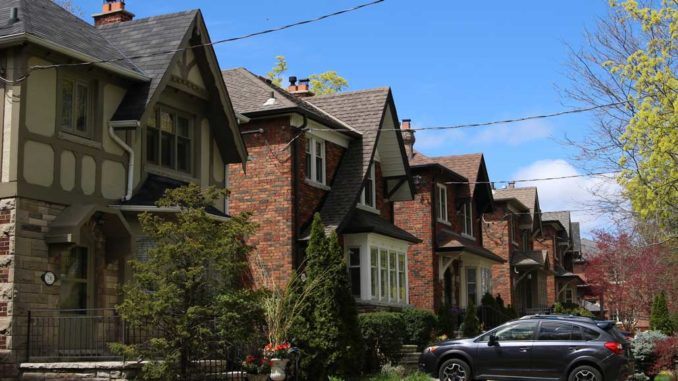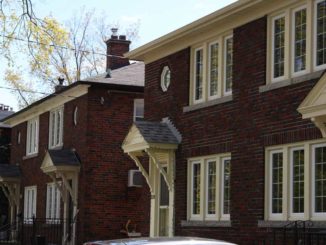
Two songs are competing for space in my head. Joni Mitchell’s Big Yellow Taxi (“They paved paradise…”) and Pink Floyd’s Another Brick in the Wall (“We don’t need no thought control…”). What’s racking my brain? Well, in May 2014, then Councillor Parker recommended that Leaside be considered a Heritage Conservation District (HCD).
An HCD is a geographically defined area noted for its distinct heritage character. Geoff Kettel notes we were prioritized “below the line” at that time. Phew. In my mind, that was a close call, and if it had proceeded, we would have needed to strap on our thinking caps and come to a collective agreement on how best to proceed. Is a Cultural Heritage Resource Assessment study (CHRA) in the cards for Leaside in 2020? If so, we will be venturing further down the path to south Leaside (“nominated area”) being designated an HCD.
As a property owner, I naturally wondered what this would mean for me. As I understand, if a property is part of a registered HCD, it is protected by the Ontario Heritage Act. A property owner will require a heritage permit (approved by council) to conduct any major exterior alterations or demolitions and must have regard for the existing built form and character of the neighbourhood with respect to its form, materials, height and massing in design proposals as well as avoid removal of original building details, mature trees and other character-defining elements of the property per the district plan and legislation. Since 2005, properties in new HCDs must have HCD bylaws registered on title at the local Land Registry Office.
Is this something we really need?
To unpack this, I first took an economic view by examining the impact of a cultural heritage designation on residential home prices. The research is inconclusive. A 2017 study in the Economic Journal found “no significant short-run effects of designation and some evidence of positive capitalisation effects in the long run. There is some evidence of positive spillovers onto properties just outside.” A 2019 study in the Journal of Economic Geography found “conservation areas lead to higher house prices for given land values and building costs (lower housing productivity) and higher house prices for given wages (higher quality of life). The overall welfare impact [collective view vs. individual owner view] is found to be negative.” The term “welfare effects” refers to the point that some neighbourhoods in the US have been accused of using heritage designations as a way to limit the prevalence of more affordable housing thus negatively affecting the overall social good of a district within the context of a larger economic good for a city. Bottom line? There was no definitive empirically supported answer and outcomes are situational.
I then considered the idea of relinquishing more control to the legislative government. My perspective may cloud judgment as I am loath to do so unless the matter is supported by considerable evidence. That same 2019 study also suggests that “more recent designations are typically of a less distinctive heritage character, and perhaps only of local significance…[of which] designation status is largely determined by local homeowners who stand to gain from the localised benefits of the policy.” Gains which I feel are somewhat questionable. There are already 21 HCDs in Toronto preserving buildings of significance (e.g. Gooderham Building, Enoch Turner Schoolhouse) and neighbourhoods (e.g. Rosedale, Annex, Yorkville, St. Lawrence) that are representative of Toronto’s cultural heritage (early character and architectural style). What could a Leaside HCD add to the list that would be worth ceding greater government oversight in exchange for limited social and economic gain?
What in Leaside would be worth preserving?
To designate only and all of south Leaside as a heritage district misses the mark and paints with too broad a brush. Perhaps rather than nominating the entirety of south Leaside, we could focus on specific structures from the “agricultural settlement landscape” and possibly worthwhile ones from the “developed residential landscape.” If we were to start with a blank page, the things that need to be protected and nurtured are not related to the aesthetic design of a structure’s façade, but (1) the very empowering idea of Frederick Todd’s original garden city concept that showcased the powerfully successful synergy that is generated when residential and industrial space are interconnected at birth by clever design, and (2) the real connectedness residents have with the original natural “pre-settlement landscape” (i.e. our relationship to the natural land and Don Valley tributaries). Nominating a heritage district that encompasses a combination of both the industrial and residential space which was at the heart of the garden city design is unique to Ontario and one of only three in Canada – this is our most compelling story. It’s a cultural heritage worth preserving because it also informs the way forward for Millennial and Gen-Z Leasiders beginning to reimagine how they will live, work, learn and play.
We should somehow be able to honour the past without being shackled by it, and more importantly, we must embrace the future.
Should Leaside be designated a cultural heritage district? What more can Leaside add to Toronto’s cultural heritage story? Is becoming an HCD a self-indulgence unworthy of relinquishing more control to the government? Let us know at .
Leasider Glenn Asano is a partner and principal consultant for the strategy and business development practice at Centred Performance. He is also an Instructor with the Ted Rogers School of Management at Ryerson University.



